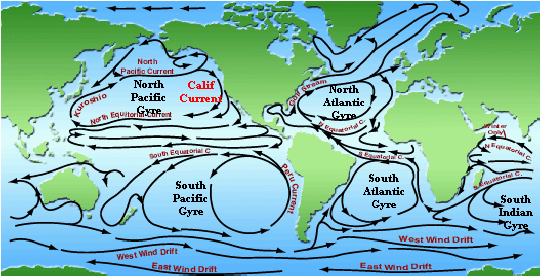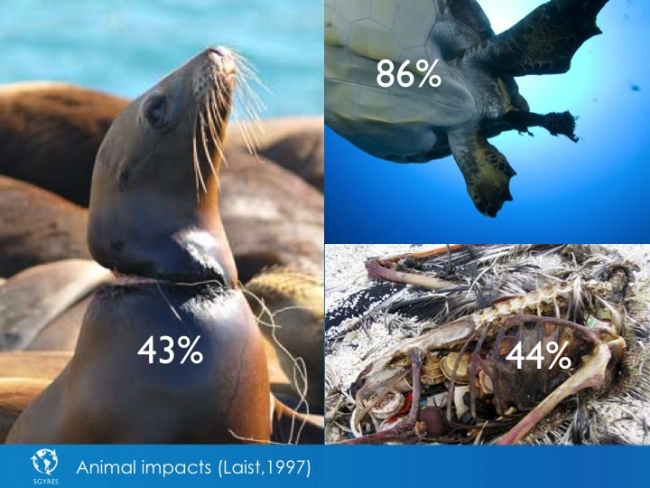 I have been obsessing about the “garbage patches” in the gyres of the world since reading some information about them I hadn’t previously heard. In the book “The World Without Us”, by Alan Weisman, he tells the story about Captain Charles Moore, who in 1997 inadvertently steered himself into the largest collection of garbage in the ocean, a spot in the North Pacific Gyre that scientists termed the Great Pacific Garbage Patch. This patch, like others in the ocean, is formed by a combination of factors: rotating patterns of hot wind, resulting in circular currents in the ocean swirling into a vortex, and then the accumulation of trash from our rivers that empty into the ocean, as well as trash that is dumped directly from ocean-going vessels being sucked into the circulating vortex, like a big giant toilet that won’t flush.
I have been obsessing about the “garbage patches” in the gyres of the world since reading some information about them I hadn’t previously heard. In the book “The World Without Us”, by Alan Weisman, he tells the story about Captain Charles Moore, who in 1997 inadvertently steered himself into the largest collection of garbage in the ocean, a spot in the North Pacific Gyre that scientists termed the Great Pacific Garbage Patch. This patch, like others in the ocean, is formed by a combination of factors: rotating patterns of hot wind, resulting in circular currents in the ocean swirling into a vortex, and then the accumulation of trash from our rivers that empty into the ocean, as well as trash that is dumped directly from ocean-going vessels being sucked into the circulating vortex, like a big giant toilet that won’t flush.
The current size of this patch is estimated to be about twice the size of Texas, although it is hard to measure precisely. In 2005, Captain Moore began making references to it encompassing 10 million square miles – nearly the size of Africa. By this time, Moore had formed the Algalita Marine Research Foundation to study this patch and try to find a way to remedy it. Moore’s original estimate of the amount of trash in this pacific gyre was initially 3 million tons of plastic; an estimate corroborated by the Navy. Later, he went back with a trawling device and realized it was much more than that, and that the ocean in this spot carried six times more plastic by weight than plankton. It is suspected that 80% of the trash inside this patch, and the other large patch like it on the other side of the earth, originates from the land: flying away from landfills, dumped into our rivers, plastic bags on a runaway mission to join this collection and entangle marine mammals. The remaining 20% comes from ocean vessels, which contribute a shocking amount: a typical 3,000 passenger cruise ship produces over eight tons of solid waste weekly, a portion of which ends up in the patch. As early as 1975, it was estimated that ocean going vessels were dumping an average of 8 million pounds of plastic annually. More recent research quoted in Weisman’s book suggests the merchant fleet is dumping about 639,000 plastic containers every day.
The sad fact is that the ocean life is being affected in alarming ways from this. “Ghost” fishing lines and nets can entrap ocean animals. Animals get the plastic caught up on them and suffer as a result. Also, the plastic bits in the trash are ending up in all parts of the food chain. Some of the plastic slowly breaks down by the process of photosynthesis and ends up in small particles at the surface of the ocean, where it is consumed by filter feeders. Small nurdles of plastic (nurdles are the tiny pieces of pre-production plastic resin) are consumed by krill, which then die prematurely. These nurdles make up a good portion of the garbage patches, and act like sponges for toxins such as PCB and DDE, which then intensify as they attach to the nurdles, becoming 100 million times higher in levels than surrounding seawater. Puffins have been found with this alarmingly high amounts of PCBs and DDE as a result of consuming these nurdles. Seabirds are found dead with stomaches full of plastic. Since at least 2008, concerned scientific groups have been trying to come up with a solution on how to clean up these areas. Some of the ideas are really promising, like an idea presented at TEDxDelft2012 by a Dutch Aerospace Engineer named Boyan Slat that proposed using surface currents to let the debris drift to specially designed arms and collection platforms. Running costs would be virtually zero, and the operation be so efficient that it may even be profitable. According to Boyan Slat’s calculations, a gyre could realistically be cleaned up in five years’ time, collecting at least 7.25 million tons of plastic combining all gyres.
Since at least 2008, concerned scientific groups have been trying to come up with a solution on how to clean up these areas. Some of the ideas are really promising, like an idea presented at TEDxDelft2012 by a Dutch Aerospace Engineer named Boyan Slat that proposed using surface currents to let the debris drift to specially designed arms and collection platforms. Running costs would be virtually zero, and the operation be so efficient that it may even be profitable. According to Boyan Slat’s calculations, a gyre could realistically be cleaned up in five years’ time, collecting at least 7.25 million tons of plastic combining all gyres.
Without a radical change to our plastics practices, though, it might be a futile attempt. We need ways to package food to keep it fresh and free of bacteria that is truly biodegradable and will not contaminate our oceans and our earth as it decomposes. We need to figure out ways to keep our trash in our landfills and not in our oceans.
For more information, see:
http://5gyres.org/what_is_the_issue/the_solution/